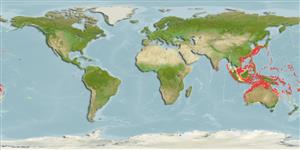Klassifizierung / Names
Namen | Synonyme | Catalog of Fishes(Gattung, Arten) | ITIS | CoL | WoRMS | Cloffa
>
Perciformes/Scorpaenoidei (Scorpionfishes) >
Scorpaenidae (Scorpionfishes or rockfishes) > Pteroinae
Etymology: Pterois: Greek, pteron = wing, fin (Ref. 45335); paucispinula: Name from Latin which means 'few spines'; referring to the small number of spinules on the head and body ctenoid scales.
Environment: milieu / climate zone / depth range / distribution range
Ökologie
seewasser riff-verbunden; tiefenbereich 1 - 440 m (Ref. 101439). Tropical (Ref. 114776)
Verbreitung
Länder | FAO Gebiete | Ecosystems | Vorkommen | Point map | Einführungen | Faunafri
Indo-West Pacific: from India to northern Australia (Timor Sea); north to southern Japan; eastwards to Wallis and Futuna Islands.
Size / Gewicht / Alter
Maturity: Lm ? range ? - ? cm
Max length : 14.4 cm SL Männchen/unbestimmt; (Ref. 101439)
Kurzbeschreibung
Bestimmungsschlüssel | Morphologie | Morphometrie
Rückenflossenstacheln (insgesamt) : 8; Rückenflossenweichstrahlen (insgesamt) : 10 - 11; Afterflossenstacheln: 3; Afterflossenweichstrahlen: 6. This species is distinguished from its congeners by the following combination of characters: D XIII, 10 (rarely XIII, 11); pectoral-fin rays 17-19 (modally 18); scales below lateral line 11-15 (13); body depth at anal-fin origin 26.0-32.8 (mean 30.2) % SL; head width 12.6-15.6 (14.4) % SL; postorbital length 15.4-20.0 (18.1) % SL; longest dorsal-fin spine length 42.9-51.7 (47.8) % SL; caudal-peduncle depth 9.9-11.9 (11.0) % SL; pectoral fin with 14-28 relatively large (subequal to pupil diameter) black blotches on membrane, several bands on the posterior portion of rays (not attached to membrane); several narrow to wide vertical bands laterally on body and caudal peduncle; the area of ctenoid scales on body is relatively small (usually dorsolateral region only at ca. 90 mm SL, sometimes extending below lateral line onto ventrolateral region, and on pectoral-fin base and laterally on caudal peduncle in adults greater than 80 mm SL (Ref. 101439).
Life cycle and mating behavior
Geschlechtsreife | Fortpflanzung | Ablaichen | Eier | Fecundity | Larven
Matsunuma, M. and H. Motomura, 2015. Pterois paucispinula, a new species of lionfish (Scorpaenidae: Pteroinae) from the western Pacific Ocean. Ichthyol. Res. 62(3):327-346. (Ref. 101439)
IUCN Rote Liste Status (Ref. 130435: Version 2024-1)
Bedrohung für Menschen
Harmless
Nutzung durch Menschen
Fischereien: kommerzielles potential
Tools
Zusatzinformationen
Download XML
Internet Quellen
Estimates based on models
Phylogenetic diversity index (Ref.
82804): PD
50 = 0.5005 [Uniqueness, from 0.5 = low to 2.0 = high].
Bayesian length-weight: a=0.01000 (0.00440 - 0.02274), b=3.02 (2.83 - 3.21), in cm total length, based on LWR estimates for this (Sub)family-body shape (Ref.
93245).
Trophic level (Ref.
69278): 3.8 ±0.6 se; based on size and trophs of closest relatives
Widerstandsfähigkeit (Ref.
120179): mittel, Verdopplung der Population dauert 1,4 - 4,4 Jahre. (Preliminary K or Fecundity.).
Fishing Vulnerability (Ref.
59153): Low vulnerability (10 of 100).
